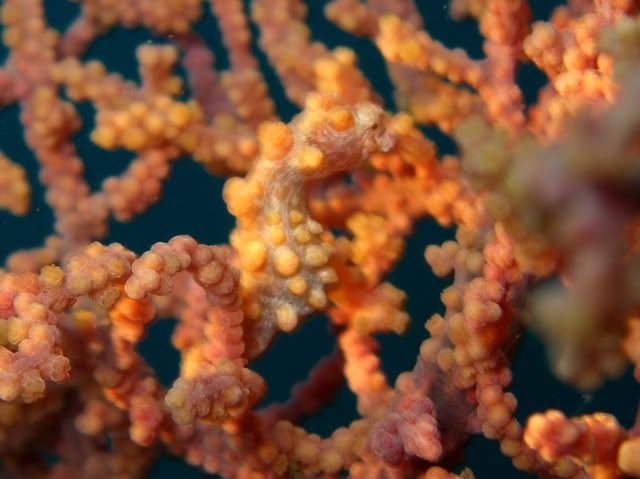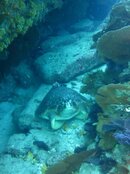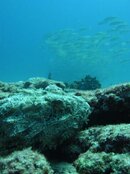You are using an out of date browser. It may not display this or other websites correctly.
You should upgrade or use an alternative browser.
You should upgrade or use an alternative browser.
What we don't see down there...
- Thread starter Mike Boswell
- Start date
Please register or login
Welcome to ScubaBoard, the world's largest scuba diving community. Registration is not required to read the forums, but we encourage you to join. Joining has its benefits and enables you to participate in the discussions.
Benefits of registering include
- Ability to post and comment on topics and discussions.
- A Free photo gallery to share your dive photos with the world.
- You can make this box go away
Spotting critters is an extended part of general dive awareness. It is no accident that more experienced divers spot things that rookies have swum past. A lot of newer divers particularly don't think in three dimensions and fail to look up. I often see divers stick their heads into caves and fail to see a lobster clinging to the roof or a moray eel just above their head. Similarly, people are so often fixated on the reef that they fail to spot the large pelagic swimming gently by overhead.
Tigerman
Contributor
Because James Bond would! And his would probably fit in the document case hes carrying in the trunk of the car..
Rhone Man does also have a point, it does take practice to spot "things" down there. I do notice that I spot a lot more stuff, and especially small stuff now than I did on my first dives.
Rhone Man does also have a point, it does take practice to spot "things" down there. I do notice that I spot a lot more stuff, and especially small stuff now than I did on my first dives.
- Messages
- 93,544
- Reaction score
- 91,968
- Location
- On the Fun Side of Trump's Wall
- # of dives
- 2500 - 4999
Ah, that's what those are! I found one in Bunaken ... he thought he was hiding ...Couple of examples of my aforementioned slow-ass looking for stupid hiding critters...
I Know, the second one is out of focus.. Because its so damn elusive and hiding in stuff messing with my focus

These are the ones I had trouble seeing ...

... Bob (Grateful Diver)
Critter spotting is a learned skill, and a lot of fun.
I learned it at about age 12, living on an island in south GA with very little in the way of indoor amusements. A friend's dad took him deer hunting from a tree stand, and his excited stories about watching the deer and the excellent bird's eye view sounded just great. So we built a stand of our own just to sit and see what we might see. Wow: we had an absolutely excellent time just learning to watch and listen. We saw a lot of deer, also whole packs of wild hogs, birds, and a fox (from about 4' away) with the most brillant, beautiful coloring I could have imagined. Just a year or so later I noticed that my eyes had learned to pick out shapes and detect movement in a way they never couple before. I'd become a little like my dad: dad would occasionally pull onto the shoulder of an interstate and point out a deer herd hundreds of yards away at the edge of a forest. He'd see things like that in his peripheral vision while travelling 60 mph!
But it's the same while diving. Anyone can see lots of additional things by slowing down and looking a bit more carefully, but once you start to make a habit of it your ability to see/spot/detect will develop in ways you would never have guessed it could.
I learned it at about age 12, living on an island in south GA with very little in the way of indoor amusements. A friend's dad took him deer hunting from a tree stand, and his excited stories about watching the deer and the excellent bird's eye view sounded just great. So we built a stand of our own just to sit and see what we might see. Wow: we had an absolutely excellent time just learning to watch and listen. We saw a lot of deer, also whole packs of wild hogs, birds, and a fox (from about 4' away) with the most brillant, beautiful coloring I could have imagined. Just a year or so later I noticed that my eyes had learned to pick out shapes and detect movement in a way they never couple before. I'd become a little like my dad: dad would occasionally pull onto the shoulder of an interstate and point out a deer herd hundreds of yards away at the edge of a forest. He'd see things like that in his peripheral vision while travelling 60 mph!
But it's the same while diving. Anyone can see lots of additional things by slowing down and looking a bit more carefully, but once you start to make a habit of it your ability to see/spot/detect will develop in ways you would never have guessed it could.
Part of planning a dive is planning the activity on the dive. In some dives the objective may be to swim to a location and do something there, and swim back. Other dives the objective may be to carry out a task like a search and recovery pattern, focused on the object of the search. Some dives might literally be a race with DPV's, like they have in Florida. But when the purpose of the dive is to enjoy being in the marine environment, the way to see interesting things is to relax, have a buddy looking one way and you the other until something interesting or new is seen, and then watch it. Debbie and I love watching animal behavior, whether breeding, nest building, hunting, eating, cleaning, territorial defense, or anything else. To do that you can't be made to rush to stay with the dive leader and group. We are fortunate to dive our own profiles on nearly every dive. (current professional rating and current DM insurance) Liveaboards offer that kind of freedom as well. However, we all have experienced the day boat DM led dive that has a group swimming along with little or no pauses, and those quite short. It's still fun diving, but it's not the same. One of our favorite dives ever involved moving a total of less than 50 yards on an entire dive, watching a turtle on a wall ripping and eating what I believe was sponge, and watching fish come and grab at the loose floating stuff around the turtle, sometimes being snapped at by the turtle because of getting in its face. Another time on a night dive we sat in one place and spotlighted free swimming fish, and then watched as tarpon swam in and gulped them down. Those kind of dives beat the "tour" dives every time in my book. These kind of dives do not lat 45 minutes- they can last well over an hour on a single 80 tank (ndl's permitting).
DivemasterDennis
DivemasterDennis
Last edited:
Mike Boswell
Contributor
Mike Boswell
Contributor
diveprof
Contributor
In the 90's pre-cruise ship pier era, I conducted a PADI underwater naturalist specialty class in Coz (shore diving). We spent 90% of the dive around a single coral head with a magnifying glass and identified over forty different critters and fish. It is amazing how much we "miss" on a normal dive and how much we can see if we just slow down. I enjoying taking a quality magnifying glass down from time to time and going slow....
Similar threads
- Replies
- 19
- Views
- 3,067
- Replies
- 1
- Views
- 394
- Replies
- 34
- Views
- 5,645









